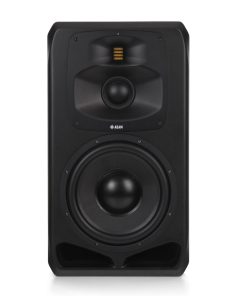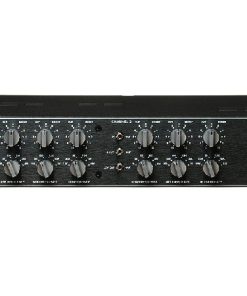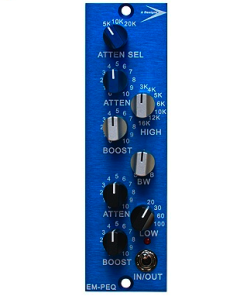AMS Neve 2254/R Mono Limiter/Compressor AMS Neve
$ 2.895,00 $ 723,75
AMS Neve 2254/R Mono Limiter/Compressor
The AMS Neve 2254/R is an exacting replica of the original 2254 80-series console compressor in rackmountable form, with save and recall of settings via USB (Mac/PC).
Like so many of Mr. Rupert Neve’s designs, the 2254 mono Limiter/Compressor unit quickly became a legend. It started out as a 2-bus compressor in 80-series consoles. Later, when it was made available as outboard as a mono compressor, its shape was an unmountable rectangular cuboid. From there, the 2254 went through three revisions*, including the 2254A, 2254E, and the current revision, the 2254/R. Not only does it retain the original 2254’s smooth, rich sonics and gain-reduction characteristics, by virtue of using the same architecture, matching components, and original hand-wound transformers, it also enhances it with modern user-requested features. Now in an easily rack-mountable 1U form, the 2254/R allows settings to be saved and recalled using Neve Total Recall software via USB.
AMS Neve 2254/R Mono Limiter/Compressor-Just the Facts
- Classic mono limiter/compressor made to the design of the late 1960s
- Hand-made in Burnley, England using original Neve specification transformers
- Original Neve 2254 discrete Class-A circuit design
- Transformer-coupled circuits used in input, bridge-driver, sidechain, and output stages
- Manual fast attack time adjustment and transparent level control
- Independent limiter in/out and compressor in/out selection
- Total-bypass switch
- Multiple units can be linked together to provide multi-unit sidechain control from a single unit
- Compatible with Neve Total Recall software; simply connect the 2254/R using USB to a host PC or Mac running Neve Recall software
AMS Neve 2254/R-Under the Hood
The 2254 is a discrete Class-A design with transformer-coupled circuitry that includes the input stage, innovative diode bridge, sidechain, and output stages, which gave the 2254 is unique sound.
However, the real magic of the 2254 is its diode bridge gain-reduction element. The bridge responds to the dynamic resistance of the diodes which changes in response to the current of the control voltage. Of course, it’s not all green lights and rights. Diode attenuators exhibit non-linear behavior and as a result, have high levels of distortion. While non-linearity and distortion can be good things in terms of producing the rich analog sound we all prefer, you can have too much of a good thing. To overcome the distortion, the level ahead of the bridge was attenuated by around 40dB, which brought it down to an acceptable level. The output of the diode bridge passed through another transformer and on to an amplifier chain (the BA183/283). The gain makeup element is also another clever bit of engineering. It’s actually a 20dB attenuator which makes up gain by reducing the amount of attenuation.
There’s also manual adjustment of fast attack time, continuously variable between 100µS and 2mS. Plus enhancement of the signal presence LED, which changes from green to red to warn of imminent clipping. Neve Recall software allows settings from the 2254/R to be stored on a PC or Mac and recalled for later use. The Recall software can also be used for all the units in the 88 Outboard range including 8801, 8803, 8804 & 8816. Multiple units can be stored and recalled together, up to a total of 16 units in any combination.
PAD For the Record-The original or prototype of the 2254 limiter/compressor was reputedly designed by David Rees, a design engineer who worked in tandem with Rupert Neve in the late ’60s. A former employee of the BBC, Rees’ original model, which laid the groundwork for the Neve 2253, was components wired inside a wooden box. By 1969, the 2253 evolved into the Neve 2254, the rectangular cuboid mentioned earlier, which also became the standard 2-bus compressor for the 80-series consoles. (The 2254 itself evolved into the Neve 33609 compressor, but that’s another history lesson). Since the introduction of the 2254, there were 3 major revisions of the original 2254; the 2254/A, the 2254/E and the current version, the 2254/R. The 2254/A had a fixed slow attack time of 5ms, while the 2254/E and later versions had the option for a faster attack time. The 2254/R offers the ability to set the attack time between 100 microseconds and 2ms.
Compressor/Limiter
The 2254/R has two chains controlling the level control element; one for compression the other for limiting.
Limiter
A yellow backlit button switches the limiter sidechain in and out of the circuit. Its level is set from +4dBu to +20dBu in 2dB steps. There are three preset recovery times; 100ms, 200ms, and 800ms, plus an automatic setting (Auto). In the Auto position, both the attack and recovery times are composite and self-adjusting. Speeds are rapid for isolated peaks while remaining slow for persistently high levels, so the impression of a normal dynamic range is preserved as the program rides on a slowly moving “gain platform”.
In its default setting, the 2254 has a slow attack time of 5ms to avoid unpleasant effects when processing certain signals such as a percussive piano or vocals. In this way, a narrow dynamic range may be achieved by feeding high levels into the 2254/R and choosing a low limit level.
When fast attack is selected, the attack time can be set from 100μS to 2mS using the associated rotary control. This control is continuously variable and is fully sweepable between those two values.
Compressor
The Compress button lights yellow when selected, and switches the Compressor sidechain in and out of the circuit. There are five preset ratios: 1.5:1, 2:1, 3:1, 4:1, and 6:1. The control characteristic is shaped so the onset of compression is smooth and progressive, the true ratio being reached within the first 5 to 10dB above the threshold. The threshold point can be varied in 2dB steps from 0dBu to +10dBu, enabling a wide variety of effects. Low ratios with a low threshold setting will preserve dynamic range and achieve a high signal-to-noise ratio. A high Ratio with a high Threshold will behave as a partial limiter.
When the threshold is below line level, the gain control provides up to 20dB of makeup in 2dB steps to restore the mean program level. The 2254/R has four preset recovery times; 100ms, 200ms, 800ms, and Auto. In the Auto position, both the attack and recovery times are composite and self-adjusting. Speeds are rapid for isolated peaks while remaining slow for persistently high levels, so the impression of a normal dynamic range is preserved.
Meter
The program meter is operated by a simple drive circuit with rapid attack and slow decay times that correspond to the typical PPM characteristic. The green led to the right side of the meter will light at a threshold of about -10dBu.
The LED turns red when the program reaches a level of +25dBu, indicating imminent clipping. The meter can be set to display either the Input signal, level, output signal level, or the amount of gain reduction applied to the signal by the compressor and limiter in total.
Applications
Due to the inherent distortion and noise floor of the diode bridge, the 2254/R has a thickening effect on program material, making a stereo pair particularly useful for adding fullness to instrument subgroups, such as drums.
The 2254/R gives you the vintage sound of the 2254 with the repeatability that the vintage models were simply not capable of. For more information, call or chat online with you PAD Studio Specialist.
Specifications
General
- Power: 500mA, 36 volts DC
- Input: 10k ohm, bridging, balanced, earth-free
Output
- Source Impedance: 80 ohms, balanced and earth-free
- Maximum Output: +26dBu into 600 ohms
- Gain: 0dB, preset adjustment
- Noise: -72.5dBu in the band 20 Hz to 20 kHz
- Frequency Response: Flat, within 1dB from 20 Hz to 20 kHz
- Distortion: 0dBu: 0.03%; (Typically measured at +8dBu, 800mS Recovery) +15dBu: 0.2%
Limiter
- Ratio: >100:1
- Level: Adjustable from +4dBu to +20dBu in 1dB steps
- Attack Time: 5mS (slow) or selectable between 100μS to 2mS (Fast)
- Recovery Time: Selectable between 100mS / 200mS / 800mS / Auto
Compressor
- Ratio: Selectable between 1.5:1 / 2:1 / 3:1 / 4:1 / 6:1
- Threshold: Adjustable from -20dBu to +10dBu in 2dB steps
- Attack Time: 5mS
- Recovery Time: Selectable between 400mS / 800mS / 1500mS / Auto
- Gain Make Up: Adjustable Gain make-up available from 0 dB to +20 dB
Meter
- Switched to indicate either:
- Gain reduction control (up to 16dB), or
- Input or Output signal level (-16dBu to +12dBu)
- Action approximates to that of PPM
Prompt Delivery and Professional Packaging
Our long-standing partnership with UPS FedEx DHL and other global carriers lets us offer a range of shipping services. Our warehouse staff is extremely skilled and will package your items according to our precise and exact specifications. Your goods will undergo an extensive inspection and be safely packaged prior to being sent out. Each day, we ship to thousands of customers in many countries. The fact that we are committed to becoming the biggest online retailer in the World is clear. These warehouses are in Europe in the same way as they are in USA.
Note: Orders that include more than one item are assigned a processing period depending on the item.
Before shipping, we will inspect thoroughly the items you have ordered. Most orders are shipped within 48 hours. Expected delivery time is between 3-7 days.
Returns
Stock is dynamic. It's not entirely managed by us since we are involved with multiple entities, including the factory and the storage. The actual stock can change at any moment. It is possible that your order may be out of stock once the order has been placed.
Our policy lasts for 30 days. We cannot exchange or refund your order if it has been 30 days from the date of purchase.
For your item to be returned it must be in its original packaging, unopened and in the condition you received it. The item must be in its original packaging.
Related products
Accessories
Microphones
Mic Preamp
500 Series
Subwoofer
Accessories
Recording Equipments
Microphones
Monitor Systems
Equalizers
Equalizers
Microphones
Accessories
Recording Equipments
Monitor
Accessories
Recording Equipments
Subwoofer
Monitor Systems
500 Series
Microphones
Recording Equipments
Recording Equipments




































































